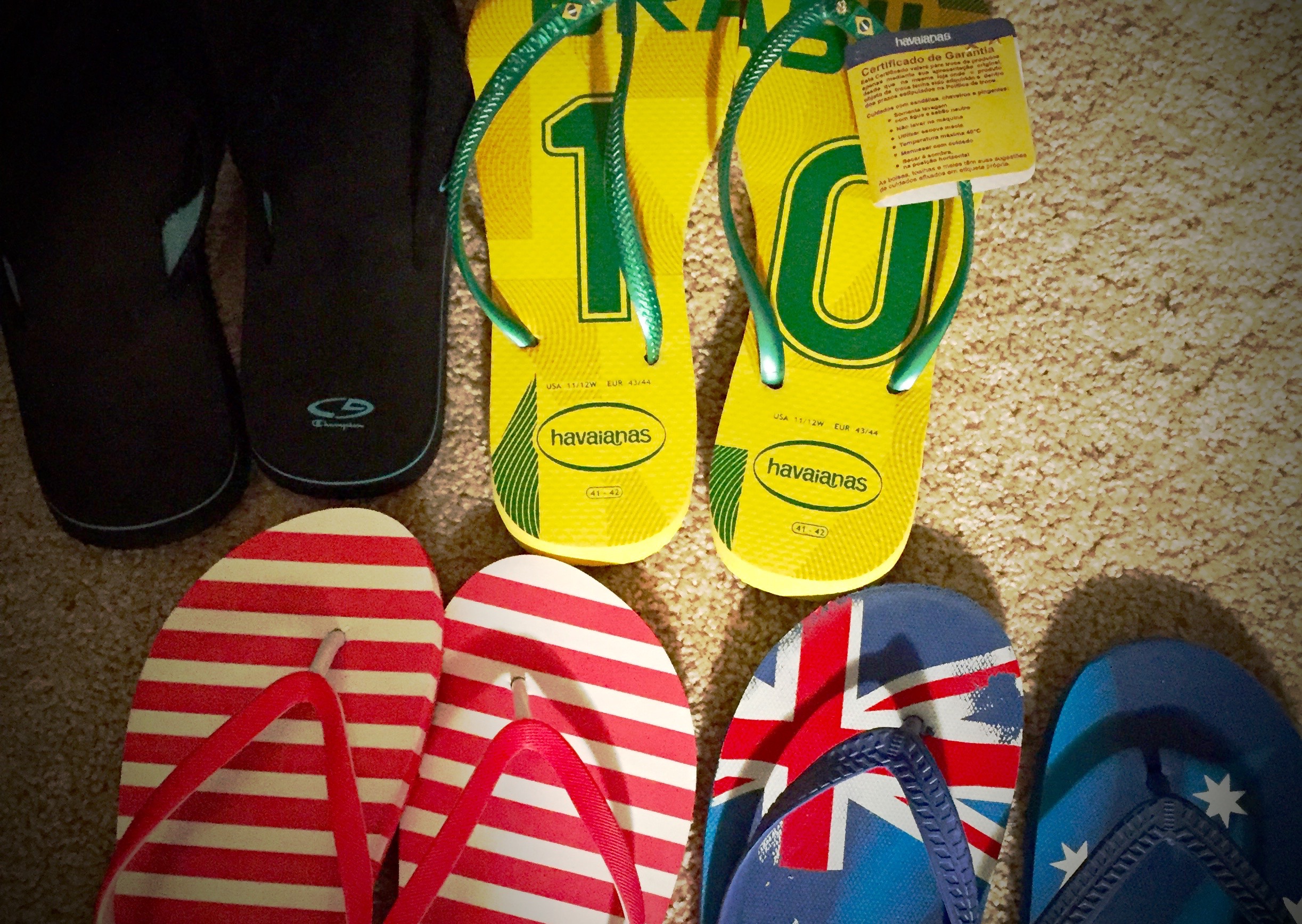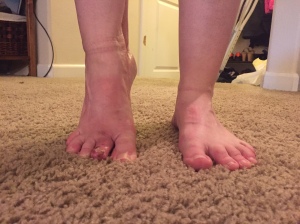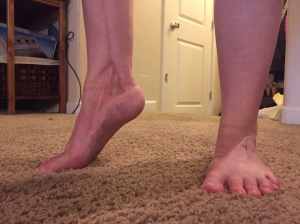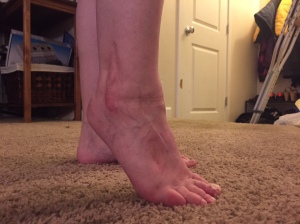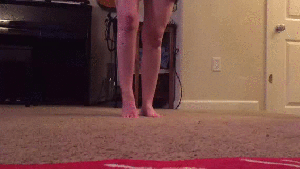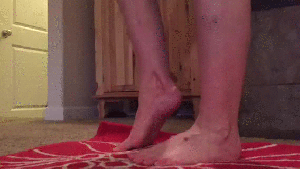I couldn’t have done this without Patrick.
He scoffs at this when I tell him, but I remind him that I simply WOULDN’T have done this without him. I had no intention of even trying to change this foot before I met him, and it was only upon his eager insistence, his unwavering optimism, and his highly convincing confidence that I was persuaded it was possible.
Early on in my married life, I came to realize the myth that all a woman has to do is sit around waiting for a prince to show up and take care of her was just that- a myth. With two children in diapers, I made the decision to take my family’s financial future into my own hands and started my degree program in Engineering. I was allowed to do this on the strict caveat that it was not allowed to cost my husband a dime. I took out loans, both subsidized and unsubsidized, finagled the department to give me a few scholarships, and gratefully relied on my little sister’s generosity as she babysat for me. My husband at the time was not the sort to get up at night with a baby, so I was still a full time mother and housewife the entire time. By the time I graduated and got a job, I was accustomed to doing everything without help- planning for my family’s future, taking care of the kids, buying and selling homes and stock investments and running the household- everything. After I left my husband, my load didn’t really get heavier, but my confidence fell and I had to learn how to do everything alone without even a cheerleader to believe in me. And so I did.
But over the past year, Patrick has taught me to let go of the reins a bit and learn to accept a little help. I still struggle with it, but there isn’t much I can do about it these days with a cage on my foot. In the hospital, he slept sideways in a recliner, his head lolling over one arm of the chair and a leg haphazardly drooped over the other. He woke instantly at the slightest sound to ask how I was doing and ran out to chase down a nurse every once in a while. He stayed right at my elbow as the physical therapist forced me to walk up and down stairs and back and forth along the hallway on my crutches before signing off on my release.
When we arrived home from the hospital, he was too worried I would fall and instead carried me up two flights of stairs like a baby in his arms. He has managed all of the instructions from the doctors as I’ve been too drugged at most of our appointments to comprehend their conversations, and he has completely commandeered control of my medications. (The two times I have taken this into my own hands so far I took the wrong dose and
didn’t write down the time.) He cooks for me, makes me coffee every morning, does all the housekeeping and laundry, and watches all five of the children.
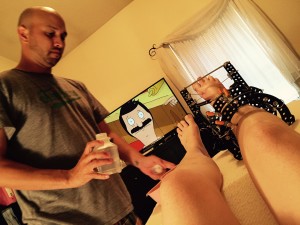
Of all of these chores, however, by far the kindest and most difficult is my pin care. Pin care is vital to prevent infection and will occur every day until my frame is removed. If performed improperly, the skin around the pins may heal wrong and cause tenting, a situation where the skin grows up around the wire in a cone and leads to skin tearing and irritation with any movement. If all of the drainage and scabbing is not removed each day, infection can brew and in no time this can lead to a deeper infection which may tract to the bone. Nearly every complication with a Taylor Spatial Frame results from problems with the pin sites and most of these can be prevented with adequate pin care.
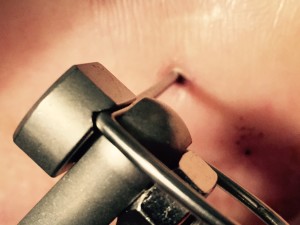
Each evening after the kids have been put to bed, I take a shower and soak my leg with the frame in water. I am only allowed to use Dial antibacterial soap and I lather up my knee as I sit on my shower bench and rinse the soap down my leg over the pins. When I’m done, I towel-dry the frame and use a fan or blow dryer to dry the rest of the droplets. I lay down in bed with my leg elevated on a one foot-high foam wedge pillow and Patrick takes over. Using a sterile cotton-tipped applicator and sterile saline, he must diligently scrub each pin and gently push the skin back from the wire all the way around. Each pin requires a fresh applicator which must be opened from sterile packaging. After the first few cleanings, the pin sites were inflamed and irritated; even gentle pressure hurt immensely and with each of my gasps he would stop
and catch his own breath, visibly upset at the pain he was causing me. He must watch for infection and monitor each bruise and blister closely to report it the doctor, and sometimes this involves tracing a line around a reddened area to see if it spreads or snapping a photo to email to my doctor. Once each pin has been cleaned, he places dry gauze carefully around
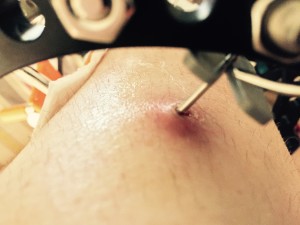
each of the pins which are still draining and tightens the plastic clip on the wire to put pressure on the dressing. When this is finished, he turns the struts. There are six of them and the changes have gotten larger as the ankle has now been separated and we are beginning the movements to raise my toes and lower my heel. He turns the dials slowly on each strut for fear of hurting me, but I groan and gasp anyway.
The entire process takes about an hour and we have a pretty good system now. He puts Bob’s Burgers on to distract me and we laugh and make fun of each other the whole time. If you don’t know Patrick, you don’t know that he is not good with these things. He cannot stand gore and his idea of what constitutes gore is pretty pathetic on my scale. While I knew I could count on him to get the door for me and help out with cooking, I honestly thought I’d be on my own with most of the raw and dirty medical procedures.
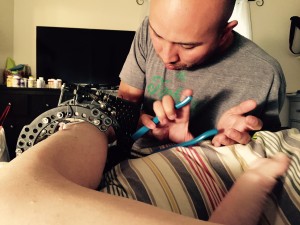
But love is odd.
Love makes hard things easy, makes weak people strong, and makes the most difficult parts of our lives the happiest. It makes a man who hates the site of blood buck up and take over without comment or complaint because he doesn’t want me to struggle on my own. It makes a woman who likes to complain bite her tongue when it hurts because I don’t want him to worry that he’s hurting me.
I can’t walk, I have a monstrosity on my foot that rivals some of the best horror movie props, and I have never been happier in my life. Thanks to love.




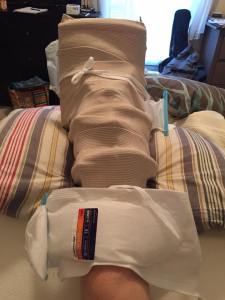 n’t much to see as the frame was wrapped in ace bandages top to bottom, completely shielding the carnage beneath. I asked for a pillow to elevate it and the nurse seemed surprised I could lift my leg without assistance as he tucked a pillow under my ankle. I’ve read many stories from others who’ve had this surgery and they are unable even to bend their knees or move their leg without manually lifting the frame with it, so I immediately felt lucky for my level of mobility.
n’t much to see as the frame was wrapped in ace bandages top to bottom, completely shielding the carnage beneath. I asked for a pillow to elevate it and the nurse seemed surprised I could lift my leg without assistance as he tucked a pillow under my ankle. I’ve read many stories from others who’ve had this surgery and they are unable even to bend their knees or move their leg without manually lifting the frame with it, so I immediately felt lucky for my level of mobility.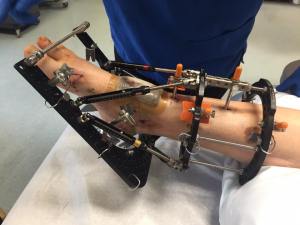 leg holding one side of the frame to the other. Additionally, four metal rods about a half-inch (Patrick says a centimeter, whatever) in diameter were drilled into the front of my tibia. In all, I have 18 holes with metal protruding out of them, or 18 pin sites as they are called in the biz. Another way to look at is 18 entry points for germs to travel straight to my bones. Infection right now is my primary enemy and my first concern is keeping those pin sites clean.
leg holding one side of the frame to the other. Additionally, four metal rods about a half-inch (Patrick says a centimeter, whatever) in diameter were drilled into the front of my tibia. In all, I have 18 holes with metal protruding out of them, or 18 pin sites as they are called in the biz. Another way to look at is 18 entry points for germs to travel straight to my bones. Infection right now is my primary enemy and my first concern is keeping those pin sites clean.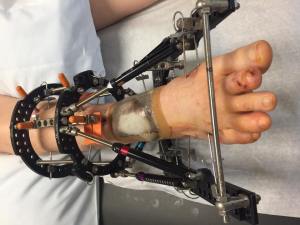 sition. In the office during this visit, the surgeon noted that one of my struts had gone slack and the number was 3mm longer than it should have been. She tightened it minimally in the office and directed us to reset it the rest of the way when we got home. That night, Patrick turned the strut, talking to me the whole time so that I didn’t even realize he was doing it. No pain.
sition. In the office during this visit, the surgeon noted that one of my struts had gone slack and the number was 3mm longer than it should have been. She tightened it minimally in the office and directed us to reset it the rest of the way when we got home. That night, Patrick turned the strut, talking to me the whole time so that I didn’t even realize he was doing it. No pain.